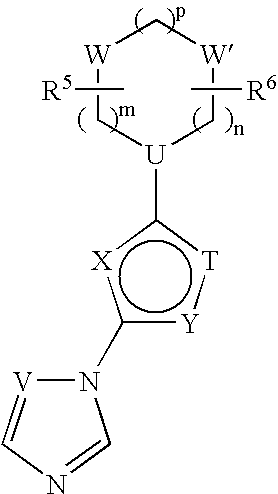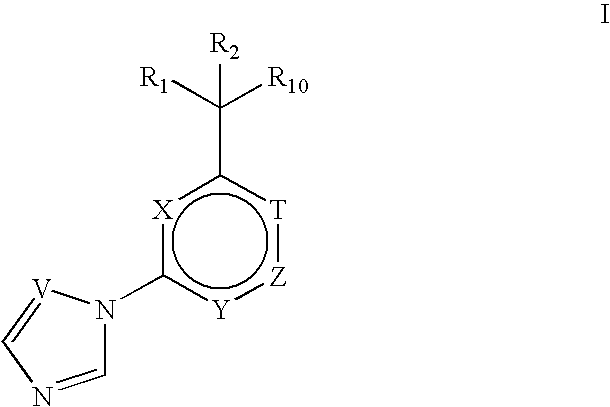Inducible nitric oxide synthase dimerization inhibitors
a technology of nitric oxide synthase and dimerization inhibitor, which is applied in the field of compound compounds to achieve the effect of using nitric oxide synthase to inhibit or modulate activity, treatment or prophylaxis of diseases
- Summary
- Abstract
- Description
- Claims
- Application Information
AI Technical Summary
Benefits of technology
Problems solved by technology
Method used
Image
Examples
example 1
[0352]
Step 1
Preparation of compound 1b: {2-[(Benzo[1,3]dioxol-5ylmethyl)-amino]-ethyl}-carbamic acid tert-butyl ester
[0353] A solution of piperonal (5.00 g, 33.3 mmol) and tert-butyl N-(2-aminoethylcarbamate(5.00 g, 31.2 mmol) in dry dioxane (70 mL) and AcOH (10 mL) was heated at 80° C. for 2 h. The solvent was evaporated prior to sequential addition of anhydrous THF (50 mL), MeOH (20 mL) and sodium triacetoxyborohydride (15.8 g, 74.5 mmol). The mixture was stirred for an additional 30 min then the solvent was removed under vacuum. NaOH solution (20% aqueous, w / w) was added to make the solution basic (pH 9), and the solution was extracted with EtOAc (150 mL). When the extracts were washed with brine, a precipitate formed in the funnel. It was filtered and dried to give 7.50 g (82%) of {2-[(benzo[1,3]dioxol-5-ylmethyl)-amino]-ethyl}-carbamic acid tert-butyl ester as a white solid.
Step 2
Preparation of compound 1c: [2-(Benzo[1,3]dioxol-5ylmethyl-methyl-amino)-ethyl]-carbamic acid...
example 2
[0361]
Step 1
Preparation of compound 2b: Benzo[1,3]dioxol-5ylmethyl-(3-bromo-propyl)-amine
[0362] 3-Bromopropyl-1-amine hydrobromide (65.6 g, 300 mmol) was slurried with CHCl3 (1.50 L) under an atmosphere of nitrogen. Triethylamine (44.0 mL, 315 mmol) was added all at once to the well stirred suspension. The mixture was stirred at ambient temperature for 30 minutes. Piperonal (45.0 g, 300 mmol) and MgSO4 (75 g) were added sequentially and the suspension was stirred at ambient temperature for 20 h. The slurry was filtered and concentrated to a white suspension. The suspension was titurated with Et2O (1 L), TEA-HBr salts removed via filtration, and the clear filtrate concentrated to afford imine (80.7 g, quant) as a clear oil. Imine (80.7 g, 300 mmol) was diluted in dry ethanol (600 mL) and acetic acid (50 mL) to afford a clear yellow solution which was cooled to 0° C. NaHB(OAc)3 (191 g, 900 mmol) was added to a vented reaction mixture portionwise (10 g portions over 1 h). The ice-ba...
example 3
[0368]
Step 1
Preparation of compound 3a: 2-ChlorocarbonyI-pyrrolidine-1-carboxylic acid benzyl ester
[0369] Oxalyl chloride (1.21 mL, 14.0 mmol) was added dropwise (15 minutes) to a 0° C. solution of N-carbobenzyloxy-D,L-proline (2.50 g, 10.0 mmol), dimethylformamide (1 drop, cat.) and methylene chloride (anhydrous, 25 mL) under a nitrogen atmosphere. The mixture was removed from the ice-bath and stirred at ambient temperature for 1 h. The reaction mixture was concentrated to afford 2.63 g (98%) of 2-chlorocarbonyl-pyrrolidine-1-carboxylic acid benzyl ester as an orange oil. The product was used directly in subsequent steps.
Step 2
Preparation of compound 3b: 2-(2-tert-Butoxycarbonyl-3-oxo-butyryl)-pyrrolidine-1-carboxylic acid benzyl ester
[0370] A solution of tert-butylacetoacetate (7.90 g, 50.0 mmol) in anhydrous THF (50 mL) was cooled to 4° C. (ice-water bath) prior to dropwise addition of methylmagnesium chloride (16.3 mL of a 3.00M solution in THF, 50.0 mmol) at such a rate ...
PUM
 Login to View More
Login to View More Abstract
Description
Claims
Application Information
 Login to View More
Login to View More - R&D
- Intellectual Property
- Life Sciences
- Materials
- Tech Scout
- Unparalleled Data Quality
- Higher Quality Content
- 60% Fewer Hallucinations
Browse by: Latest US Patents, China's latest patents, Technical Efficacy Thesaurus, Application Domain, Technology Topic, Popular Technical Reports.
© 2025 PatSnap. All rights reserved.Legal|Privacy policy|Modern Slavery Act Transparency Statement|Sitemap|About US| Contact US: help@patsnap.com



